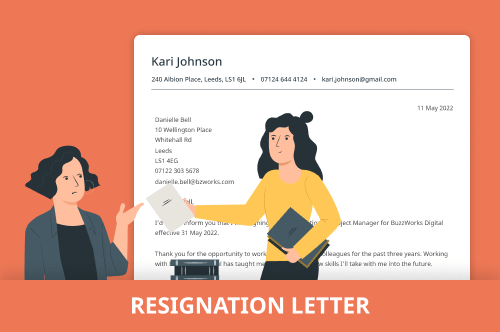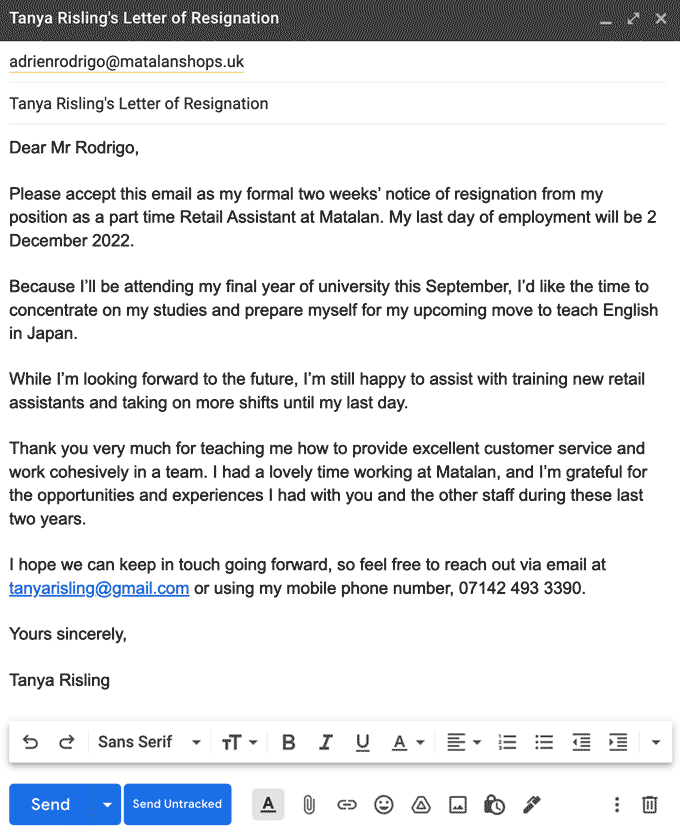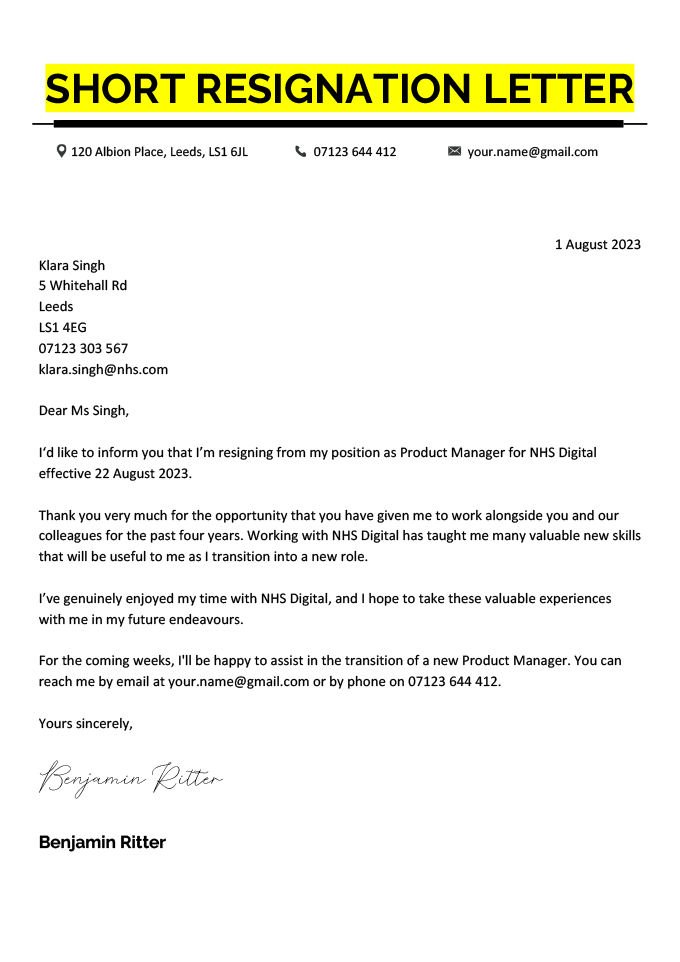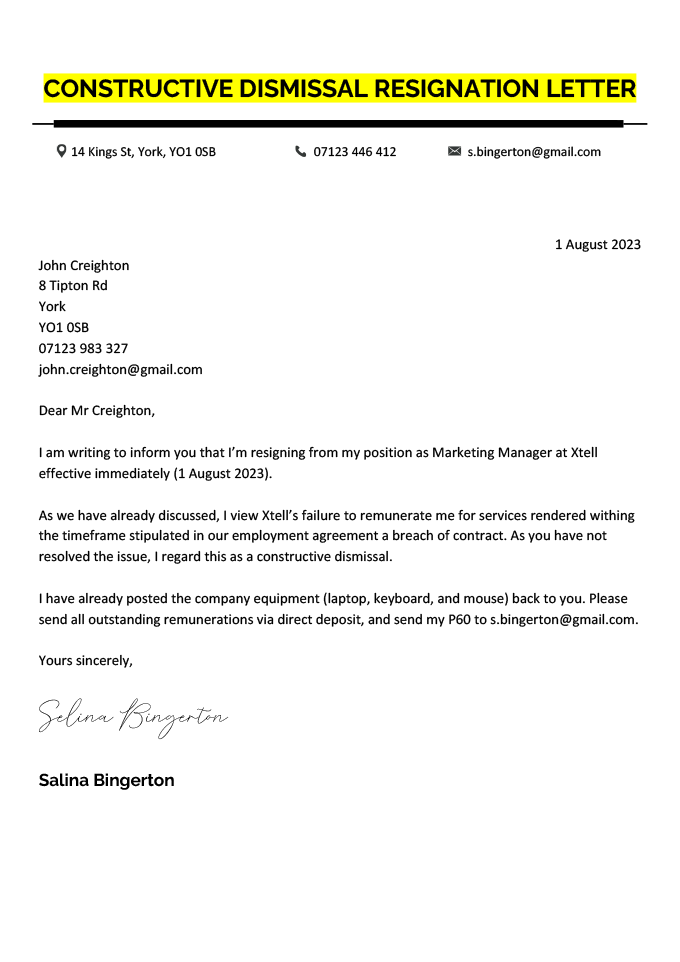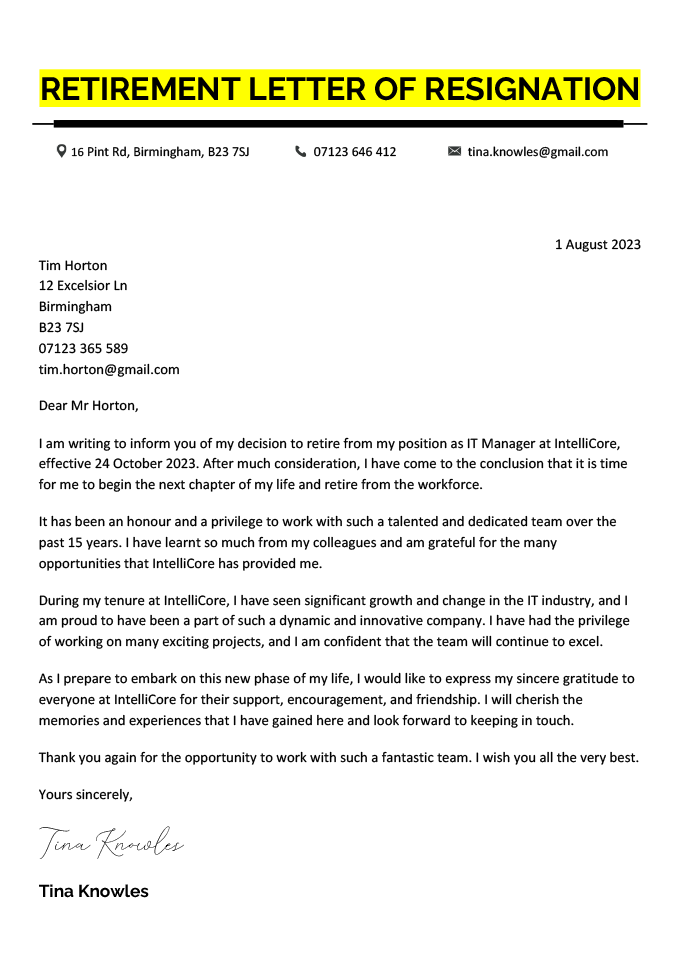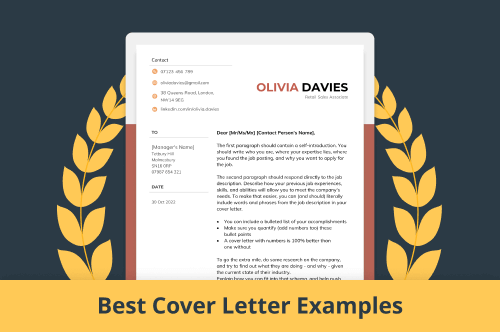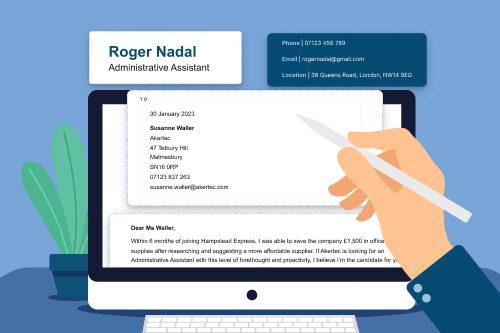A good resignation letter (or notice letter) helps you leave a job positively by giving your employer time to find a replacement and expressing your gratitude for the opportunity.
To help you with handing in your notice, we have a copy/paste resignation letter template below, followed by situation-specific resignation letter examples, writing tips, and answers to common notice-giving FAQs:
Simple resignation letter template
Below is a simple resignation letter template with formal formatting for you to copy, paste, and fill in with your unique experiences:
Examples of resignation letters
Looking for a sample resignation letter that politely explains the specific reason you’re quitting your job? Look no further. Here’s every kind of resignation letter you might need (and you can download them to use as templates for free), including a:
- Resignation email
- Short resignation letter
- Constructive dismissal resignation letter
- Retirement letter of resignation
- One week notice letter
- Two week (or more) notice letter
1. Resignation letter email
Below is a simple resignation letter email example from a student leaving a part-time job:
Resignation Email Example (Text Version)
Dear [Mr/Ms/Mx] [Contact Person’s Surname],
Please accept this email as my formal [number of weeks] weeks’ notice of resignation from my position as a [Position Title]. My last day of employment will be [DD/MM/YYYY].
Because I’ll be [insert (optional) reason for leaving], I’d like the time to [give (optional) details of your next steps].
While I’m looking forward to the future, I’m still happy to assist with [mention details of transition] until my last day.
Thank you very much for teaching me how to [list name of skill] and work cohesively in a team. I had a lovely time working at [Company Name], and I’m grateful for the opportunities and experiences I had with you and the other staff during these last [number of years or months].
I hope we can keep in touch going forward, so feel free to reach out via email at [your.name@gmail.com] or using my mobile phone number, [07123 456 789].
Yours sincerely,
[Your Name]
2. Short resignation letter
Need to fire off a quick letter of resignation? Here’s a short resignation letter example:
3. Constructive dismissal resignation letter
Below is a constructive dismissal resignation letter example to give you ideas for writing your own:
Remember that CV Genius does not claim to have legal expertise, so you should consult with a qualified solicitor to ensure you have a notice letter that meets the needs of your situation. But here is a general outline to follow when writing the content of your constructive dismissal resignation letter:
- start by informing your employer of your decision to resign, clearly listing the date you’re leaving
- state that you’re leaving due to a breach of contract
- according to Springhouse Solicitors, it’s important to clearly explain any delay in resigning to increase the chances a court won’t view that delay as you accepting the breach of contract
- note any issues that need resolved (e.g., final payment)
4. Retirement letter of resignation
Looking for a retirement resignation letter sample? Here’s a good example of how to write one:
5. One week notice letter
This is an example of a formal resignation letter giving the employer one week’s notice:
6. Two week (or more) notice letter
Here’s an example of a two week notice letter, but the content also works for longer notice periods:
How to write a resignation letter
Writing a resignation letter for the first time or just need a refresher? Here are seven tips to help you write a notice of resignation that creates a smooth exit from your current job:
1. Use business letter formatting
Following business letter formatting when writing your notice letter is important because it shows your professionalism. Also, this formal formatting includes your contact information so your employer can reach you about urgent work matters if necessary.
Follow the correct employment resignation letter format by adding your details at the top right of the page, like so:
Your contact details on a resignation letter (right-aligned)
Britta Hart
10 Stanley Street
Liverpool
L1 6BF
07354 187 434
britta-hart@gmail.com
Next, hit Enter once to add a paragraph break, and right-align the current date (using the DD/MM/YYYY format).
Providing a date to your employer officially sets the time you’re leaving and ensures you can arrange your work-related matters (such as receiving as your final pay) on time.
After writing the date, add another paragraph and include the recipient’s contact information on the left (like in the orange box below):
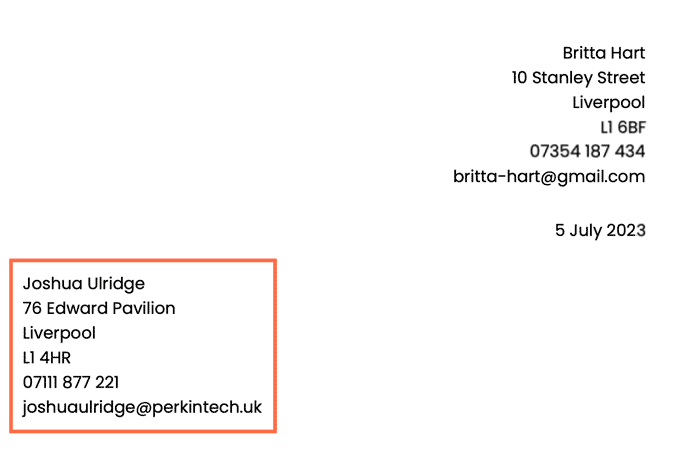
Then, add another paragraph break and address your contact person using a polite salutation such as ‘Dear’. Add the title [Mr/Ms/Mx] followed by their surname and a comma. For example:
Dear Ms Lane,
And remember to use a professional font (like Times New Roman or Arial) and keep your font size at 10–12 points when writing your resignation notice letter so your employer can easily read the contents.
2. Open with your decision to resign
Start your letter of resignation by stating your decision to resign from the company (include your job title to avoid confusion).
A typical notice letter is one page long, so keep your resignation letter short and straightforward.
Providing a reason for leaving is optional, but keep your resignation letter respectful and never badmouth your company or colleagues even if you really hate your job.
Also, if you’re writing a CV and cover letter for a future job and need a reference from your employer, maintaining a positive relationship is important — especially as you end your time working together.
Unsure how to write a great CV and cover letter? Use an online CV builder and cover letter maker that write and format your application for you to quickly find a new role.
3. State your last date of employment
State your last date of employment so your employer can plan for hiring a replacement and officially start your offboarding process.
Use the standard date format DD/MM/YYYY (for example, 30 September 2022 or 30/09/2022) to avoid any confusion about when you’re leaving.
Not sure how long your resignation notice period should be? We cover that information in our letter of resignation FAQs below.
4. Offer to help with the transition
If you’re comfortable doing so, inform your employer that you’re happy to help with the transition as you leave your role.
You may be required to train someone taking your role or hand off your current projects and tasks to your colleagues. So if you’re already familiar with your company’s resignation process, add details about how you can specifically help. Otherwise, keep this section short.
5. Thank your employer
Leaving your company is often a bittersweet experience. Because your employer has spent time, money, and resources to help you grow, remember to thank them for their efforts and wish them well in the future.
Consider mentioning a key skill you’ve picked up or work experience you’ve gained from working with the company to make your letter of resignation more personal.
6. Provide your contact information (again) and sign off
When closing your letter of resignation, include your phone number and email address again for your employer’s convenience.
Next, sign off professionally by writing ‘Yours sincerely,’. Then, if you’re:
- handing in a digital copy of your notice: add a paragraph break and type your first and last name
- giving a hard copy of your resignation letter: make an extra space between your sign-off and name for your signature
7. Proofread your resignation notice letter
Finally, proofread your resignation letter before you submit it by ensuring:
- the dates you provided are correct (don’t accidentally set your end date a month later than you planned)
- there are no grammatical or spelling errors (giving a typo-filled notice letter makes could make your manager think twice about giving you a good reference)
- your contact information is up-to-date (you don’t want to miss important messages — such as tax information)
How to prepare for your next job application after resigning
If you haven’t done so already, now’s the time to write your CV so can start to apply for new jobs. Or you can look at this example of a professional CV for inspiration:

You’ll also need a cover letter to introduce yourself and your CV. Learn how to write a good cover letter or check out this example cover letter to get ideas for writing your own:

Letter of resignation FAQs
Still wondering how to go about handing in your notice of resignation? Here are answers to three common questions about giving notice:
- Why should I write a resignation letter?
- How long of a notice period should I give my employer?
- How do I hand in a resignation letter?
- What should I do if I give in my resignation letter and I get a counteroffer?
- What should I do if my manager refuses to accept my resignation letter?
1. Why should I write a resignation letter?
You should always write a resignation letter because it’s a:
- polite custom (employers expect you to give them a resignation letter as a matter of courtesy)
- record of your exit date
- formal expression of gratitude for the opportunity to work for your employer
- good way to establish a positive relationship going forward, which can help you get positive reviews from your managers if you need them
2. How long of a notice period should I give my employer?
Unless your work contract or verbal agreement between you and your employer says otherwise, the length of your notice depends on how long you’ve worked for your employer:
- Less than one month: No notice legally required
- One month to two years: One week’s notice
- Two years or more: One week’s notice for each year you’ve worked for your employer, but only up to 12 weeks
3. How do I hand in a resignation letter?
The best way to hand in a resignation letter is via email so there’s an electronic record established — but only after you’ve discussed your resignation with your manager.
Even if you work remotely, you should try to break the news of your resignation on a video or voice call if possible because it’s the courteous, personable thing to do. Sending an email or Slack message to give notice is like breaking up with your romantic partner over text — doing so can make you seem cold, and text messages are easily misinterpreted.
4. What should I do if I give in my resignation letter and I get a counteroffer?
This question comes courtesy of u/Altruistic_Use544 on Reddit.
If you hand in your resignation letter and your company gives you a counteroffer, you can decide whether to withdraw your resignation or resign anyway.
For example, your boss might offer you a 5% pay raise and a £1,000 bonus for staying with the company. It’s up to you whether that offer fits your life situation or is a better offer than you’d get at your next job.
It’s worth getting in writing that you’ll still be eligible for your next scheduled pay raise and bonus if you accept the counteroffer’s terms.
5. What should I do if my manager refuses to accept my resignation letter?
This question was posed by a user on Quora and by u/Muta_genas on Reddit.
A resignation letter is not a request to resign, it’s a notice that you’re leaving a company, so your manager can’t refuse to accept it.
Make sure you’ve:
- got a dated record that you sent your resignation letter (e.g., Royal Mail Signed For or an email resignation letter in your email ‘sent’ folder)
- followed the law/company policy on working your notice period
As long as you’ve followed these steps, you’re free to leave your job on the date you’ve said will be your last day.
